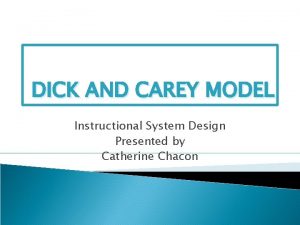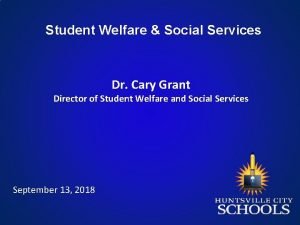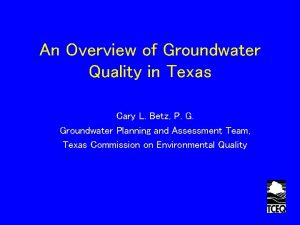Cary Duffy Director Teaching Pathways Team Quality Teaching













- Slides: 13

Cary Duffy Director Teaching Pathways Team Quality Teaching Branch Teacher Education

National reform agenda for schooling Aim: Every Australian child has access to a world class education regardless of what school they go to or where they live • Shared commitment between Australian Government, states, territories and non-government sector • To reduce disadvantage and target resources to communities most in need Reform is being implemented through: • increased funding to government and non-government schools • world-class enabling infrastructure - Digital Education Revolution, Trade Training Centres Program and Building the Education Revolution. • a wide ranging reform agenda

Education reforms l l l three Smarter Schools National Partnerships o to provide foundation skills (literacy and numeracy) o being taught by high-quality teachers o supporting disadvantaged students transparency in school performance data, reporting and assessment world-class national curriculum. transition from school close the gap between the educational outcomes of Indigenous Australians and non-Indigenous Australians 3

Smarter Schools - Improving Teacher Quality National Partnership (TQNP) $550 million over 5 years to raise teacher quality as a platform for improving student outcomes System-wide reforms targeting critical points in the teacher ‘lifecycle’ • Attract the best entrants into teaching • Train future teachers • Place and support quality teachers and leaders • Develop teachers’ and leaders’ skills and knowledge • Retain quality teachers and school leaders 4

TQNP Pre-Service Teacher Reforms Accreditation of Pre-service Teacher Education Programs (AITSL leading) l The Government’s objective is to improve the effectiveness of teacher education courses by strengthening quality assurance arrangements. School Centres for Teacher Education Excellence (state and territories leading) l To support quality pre-service teacher education through improved partnerships between schools and higher education providers Quality Placements for the Practical Component of Teacher Education Courses l To provide quality placements for the practical component of teacher education courses to equip graduates for the teaching workforce. 5

Facilitation reforms • Teacher Professional Standards • Accreditation of Pre-service (initial) Teacher Education Programs • National Consistency in the Registration of Teachers • Certification at Highly Accomplished and Lead Teacher Levels • Performance management and continuous improvement in schools • Teacher workforce data • New Pathways into Teaching • Better Pathways into Teaching • Indigenous Education Workforce Pathways • Quality placements for the practical component of teacher education courses • School Centres of Excellence • Professional development and support for principals 6

Achievements under the TQNP • Implementation of reforms at the state and territory level • internship programs • programs targeting regional areas • Centres of Excellence models which enable stronger partnerships between schools and higher education providers – Tasmania’s Partnerships in Teaching Excellence initiative is a positive example • Increased dialogue between stakeholders 7

Expanding teaching pathways Partial completion of study combined with internships and scholarships Traditional pathways Employment based Graduate Teacher 8

Issues for teaching pathways • Better alignment between teacher workforce needs and enrolments in teacher education courses to address teacher shortages. • Bradley higher education reform process, particularly demanddriven funding and publishing performance information. • State and territory level reforms and initiatives such as Queensland literacy, numeracy and science exit testing. • Address the critical problem of number of practicum placements and suitable practicum supervisors. • Preparing teachers for student diversity including Aboriginal and Torres Strait Islander student, special needs students. 9

Top of the Class report identified challenges Strategies for quality improvements • poor integration of theory and practice • lack of support for supervising teachers • increasing difficulty finding enough quality placements • mentors and education advisors appointed to support the practicum - training and release time • relationships with schools - connections between school and campus • placements in rural and remote Australia, Indigenous communities or difficult to staff schools • flexibility for family and employment commitments • time for university based teacher educators to work with schools 10

Teach for Australia Program Overview • A two year employment-based pathway. • Completion of a two year Postgraduate Diploma in Teaching through the University of Melbourne, while they teach. • Initial intensive six-week residential training and additional residential programs, online tutorials and twilight sessions. • A reduced teaching load (0. 8 FTE teacher). • Ongoing support from an in-school mentor and Educational Adviser and later on a Business Adviser. 11

Objective of Teach for Australia • To raise the profile of the teaching profession and address educational disadvantage by recruiting high calibre, non-teaching graduates and placing them in schools where they can make the most difference. • To create educational leaders for the future. 12

Teach for Australia : Evaluation findings to date Attraction l Schools impressed with the high calibre of associates Teacher education program Well received by associates, they want more time in the classroom and in-school support is important from day 1 l School experience l l Teachers initial apprehensions about the program are changing to positive because of Associates’ capable and enthusiastic in classroom performance (in comparison to other beginning teachers) Need for early communication and mentor-Associate matching 13
 Cary duffy
Cary duffy Quality career pathways
Quality career pathways Lonnie david franklin jr childhood
Lonnie david franklin jr childhood Poletime do afriky text
Poletime do afriky text Citoslovcia vlastné a zvukomalebné
Citoslovcia vlastné a zvukomalebné Cary high school website
Cary high school website Cary christian student death
Cary christian student death Příčinkové čáry
Příčinkové čáry Dick & carey model
Dick & carey model Why did she take a tiny scrap of dough?
Why did she take a tiny scrap of dough? Poklep plic
Poklep plic Zúžená část oceánů (moří) se nazývá
Zúžená část oceánů (moří) se nazývá Homework app
Homework app Bureaucratic bypass syndrome
Bureaucratic bypass syndrome

























